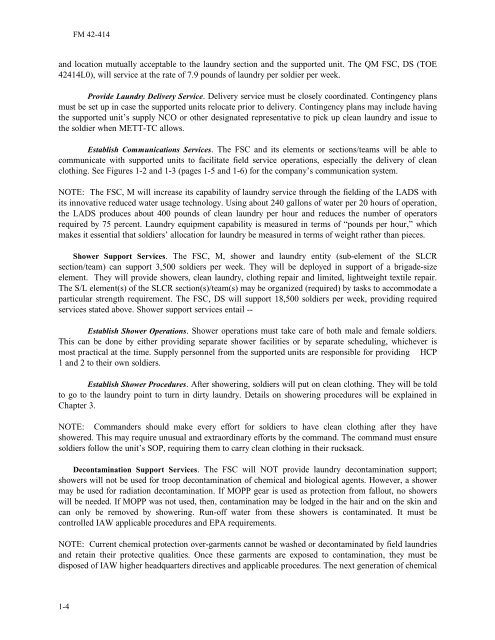Tactics, techniques, and procedures for - Army Electronic ...
Tactics, techniques, and procedures for - Army Electronic ...
Tactics, techniques, and procedures for - Army Electronic ...
You also want an ePaper? Increase the reach of your titles
YUMPU automatically turns print PDFs into web optimized ePapers that Google loves.
1-4<br />
FM 42-414<br />
<strong>and</strong> location mutually acceptable to the laundry section <strong>and</strong> the supported unit. The QM FSC, DS (TOE<br />
42414L0), will service at the rate of 7.9 pounds of laundry per soldier per week.<br />
Provide Laundry Delivery Service. Delivery service must be closely coordinated. Contingency plans<br />
must be set up in case the supported units relocate prior to delivery. Contingency plans may include having<br />
the supported unit’s supply NCO or other designated representative to pick up clean laundry <strong>and</strong> issue to<br />
the soldier when METT-TC allows.<br />
Establish Communications Services. The FSC <strong>and</strong> its elements or sections/teams will be able to<br />
communicate with supported units to facilitate field service operations, especially the delivery of clean<br />
clothing. See Figures 1-2 <strong>and</strong> 1-3 (pages 1-5 <strong>and</strong> 1-6) <strong>for</strong> the company’s communication system.<br />
NOTE: The FSC, M will increase its capability of laundry service through the fielding of the LADS with<br />
its innovative reduced water usage technology. Using about 240 gallons of water per 20 hours of operation,<br />
the LADS produces about 400 pounds of clean laundry per hour <strong>and</strong> reduces the number of operators<br />
required by 75 percent. Laundry equipment capability is measured in terms of “pounds per hour,” which<br />
makes it essential that soldiers’ allocation <strong>for</strong> laundry be measured in terms of weight rather than pieces.<br />
Shower Support Services. The FSC, M, shower <strong>and</strong> laundry entity (sub-element of the SLCR<br />
section/team) can support 3,500 soldiers per week. They will be deployed in support of a brigade-size<br />
element. They will provide showers, clean laundry, clothing repair <strong>and</strong> limited, lightweight textile repair.<br />
The S/L element(s) of the SLCR section(s)/team(s) may be organized (required) by tasks to accommodate a<br />
particular strength requirement. The FSC, DS will support 18,500 soldiers per week, providing required<br />
services stated above. Shower support services entail --<br />
Establish Shower Operations. Shower operations must take care of both male <strong>and</strong> female soldiers.<br />
This can be done by either providing separate shower facilities or by separate scheduling, whichever is<br />
most practical at the time. Supply personnel from the supported units are responsible <strong>for</strong> providing HCP<br />
1 <strong>and</strong> 2 to their own soldiers.<br />
Establish Shower Procedures. After showering, soldiers will put on clean clothing. They will be told<br />
to go to the laundry point to turn in dirty laundry. Details on showering <strong>procedures</strong> will be explained in<br />
Chapter 3.<br />
NOTE: Comm<strong>and</strong>ers should make every ef<strong>for</strong>t <strong>for</strong> soldiers to have clean clothing after they have<br />
showered. This may require unusual <strong>and</strong> extraordinary ef<strong>for</strong>ts by the comm<strong>and</strong>. The comm<strong>and</strong> must ensure<br />
soldiers follow the unit’s SOP, requiring them to carry clean clothing in their rucksack.<br />
Decontamination Support Services. The FSC will NOT provide laundry decontamination support;<br />
showers will not be used <strong>for</strong> troop decontamination of chemical <strong>and</strong> biological agents. However, a shower<br />
may be used <strong>for</strong> radiation decontamination. If MOPP gear is used as protection from fallout, no showers<br />
will be needed. If MOPP was not used, then, contamination may be lodged in the hair <strong>and</strong> on the skin <strong>and</strong><br />
can only be removed by showering. Run-off water from these showers is contaminated. It must be<br />
controlled IAW applicable <strong>procedures</strong> <strong>and</strong> EPA requirements.<br />
NOTE: Current chemical protection over-garments cannot be washed or decontaminated by field laundries<br />
<strong>and</strong> retain their protective qualities. Once these garments are exposed to contamination, they must be<br />
disposed of IAW higher headquarters directives <strong>and</strong> applicable <strong>procedures</strong>. The next generation of chemical

















